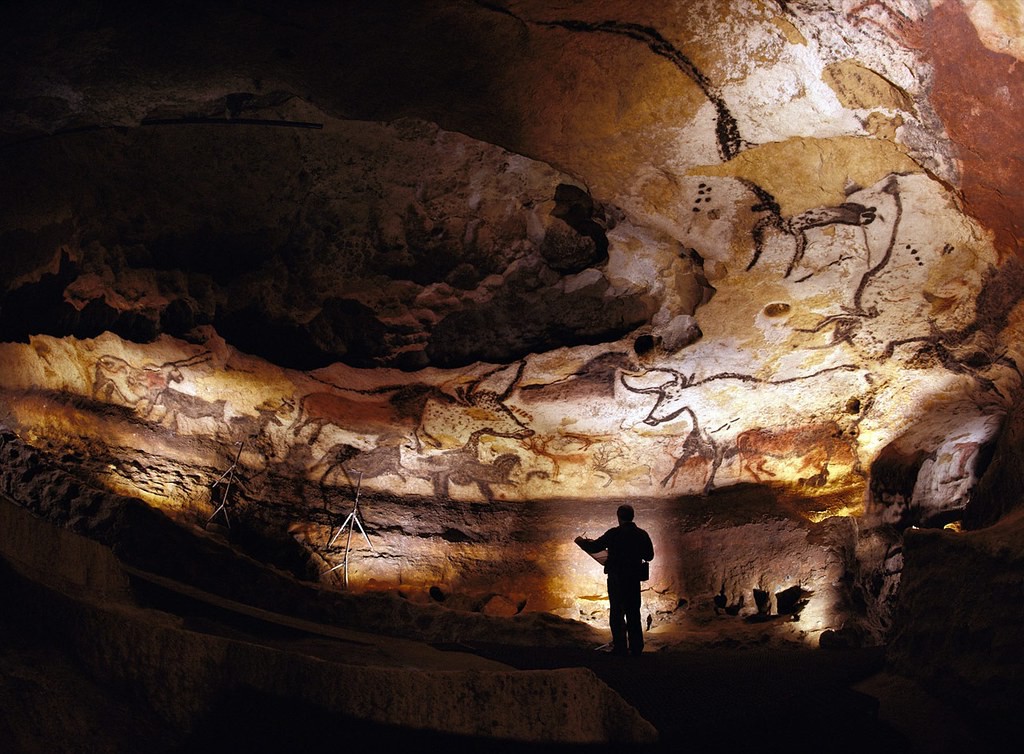1.1 Preface to the Birth of the Visual Arts
The earth is perhaps 4,500,000,000 years old, a figure which is more easily expressed as 4.5 billion years. In The Language of God, Francis Collins compressed those years into a single 24-hour day. On his clock:
- The earth was created at 12:01 AM.
- Life appeared at 3:30 AM, and then there was a slow progression to multi-cellular organisms.
- The Cambrian explosion happened at 9:00 PM and mammals started expanding over the earth.
- The dinosaurs became extinct at 11:40 PM.
- The divergence between chimps and humans occurred at 11:58:47.
- Humans appeared at 11:59:57.
- According to Collins, we homo sapiens occupy the last millisecond of those 24 hours!
Another way to look at time is from a geological/anthropological perspective. The Pleistocene era, or Ice Age, occurred between 2,588,000 to 11,700 years ago. The latter part of that geological period corresponds with the Paleolithic Period, or Old Stone Age (between 35,000 and 10,000 BCE1), when homo sapiens became more dominant. Those dates sound incredibly separated from today’s millisecond in the 21st century CE, but according to Collins’ clock, that was not really so far in the distant past as a casual reading of science might suggest. So what did those hunter-gatherer nomads, following animal herds and foraging for a few edible berries, possibly have in common with sophisticated homo sapiens of today? The environment of the ancients, their historical awareness, their academic traditions and methods differed from ours, but they asked the same questions as we. They, too, had hopes and fears, dreams and stories. Like us, they found it astonishing that we are here at all and wanted to know why. As fellow humans in this “last millisecond,” we, too, are seeking meaning through human accomplishment.
Let’s examine four human achievements that were made in those early days of caves and stone tools. These accomplishments form the beginnings of culture and have become the legacy upon which our individual and communal life is built. In their search for the meaning of life, the accomplishments which our ancestors started will be accumulated and developed over time, to be passed down from one generation to another.
Human accomplishment #1. Problem Solver. Achievement is all about creating what does not yet exist. Accomplishments are limited only by the creativity of the human mind. By rethinking the past we change how we see the present, which prompts us in turn to re-imagine the future.
Human accomplishment #2. Symbolic Thinking. Symbolic thinking distinguishes homo sapiens from all other species, freeing our minds from the restraints of “animalistic” thought to be creative, to enter and imagine other worlds which are infinite in time and space. The vitality and remarkable skill with which Cro-Magnon art was created is evidence of a self-identity and an intentional composition. Concrete expressions of consciousness have lead to the multiplicity of today’s symbols, such as signs which guide us down the highway, the wedding ring on my finger, and the icons on an iPhone. Only humans create symbols for themselves and for other humans.
Human accomplishment #3. Creator of Art. We have been art makers for as long as we have been human. Aesthetic and spiritual expression is basic to human behavior. Even Cro-Magnons cared about how a thing looked. Art shows an aesthetic need: they didn’t have a surplus of free time, their creation was not immediately more useful, and their art was not necessary for survival. Visual art is more basic than the written word. People drew pictures before writing was invented; children draw before they can write. Without art we’re just primates with car keys. Art is a necessity, not a luxury.
Human accomplishment #4. Inventor of Ritual (ceremony). Art is not always a finished, unchanging product. What do a painter, a poet, a dancer and an actor have in common? An artist is one who takes the ordinary and makes it special. One can create a bowl out of mud, but it needn’t be left ordinary. The artist can make it special by engraving a pattern or figures on it. The poet takes common words and makes them unforgettable. An artist places the activity of an artifact in a realm different from the everyday. Without the chant, the music, the masks, the dance, the performance and the painting we are left with nothing.
What are the arts of our time? Some examples might include advertising, blockbuster movies and participatory rituals, such as Super Bowl events or Olympic ceremonies. Without a doubt, you can name many more examples.
It is in the Paleolithic era that we have the birth of human accomplishment. In the cave at Lascaux [image 1.1] we witness a statement of self-awareness. They recognized their fragility amidst powerful natural forces, forces which they could identify but over which they had no control. They detected their status as a link in the food chain, and knew that they would lose. They acknowledged the passage of time and their finiteness and mortality. They used their creativity to communicate with each other and with us, symbolically expressing their limitations and powerlessness. And yet, in their struggles against decay, death and time their accomplishments declared, “I am.” “I am here.” “I am unique.” “This is ME.”

After visiting Lascaux Cave in France and the caves at Altamira in Spain, Picasso reportedly declared, “We have invented nothing!” We should not be surprised. These objects of human creativity are not arcane, obscure or hopelessly out-of-date. They are telling their story, and our story as well. We, too, are seeking the meaning of life through the vehicle of human accomplishment. We owe a debt to these ancient cultures. We cannot disconnect from them any more than they can disconnect from us.
References:

